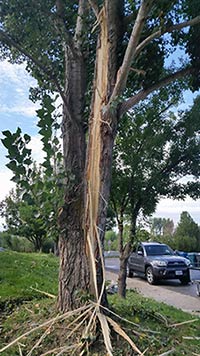Homeowners Amanda and John Hale experienced repeated power surges over four years, causing many thousands of dollars in damage to their appliances. Amanda Hale said “sparks just started flying from the ceiling fan” during a power surge. If you experience repeated power surges, it’s important to find the cause. Having an electrician perform an electrical inspection can determine if you have faulty wiring or if the problem is outside of your home. An experienced electrician will be able to make recommendations to solve your power surge problems.
Power surges can also be caused by the use of home appliances and power hungry devices in your home. Motor driven devices such as electric tools, hair dryers, pool pumps, or air conditioners can draw a lot of electricity. When the electrical load being drawn changes as a result of the device being turned off or switching cycles the excess current now has to go somewhere.
Whole House Surge Protection
Installing a whole home surge protector on your outside electrical meter would protect your whole home’s electrical system, especially motorized devices like your refrigerator, A/C, and other appliances from outside power surges. Typical outside power surges come from weather related issues, or variances from the electric utility. However, device specific surge protection is still an essential part of protecting your electronic devices.
Device Specific Surge Protection
It is a good idea to have device specific surge protection for your expensive electronics. Typically this is a surge protector. A surge protector is similar to a power strip in appearance as both are designed with multiple outlets. However, don’t make the mistake of assuming that a typical power strip offers you surge protection, as most do not. A surge protector will have a clamping voltage and an energy absorption rating. A lower number on the clamping voltage is ideal, but look for something around 400 v or lower. The clamping voltage rating lets you know when the power strip will start absorbing the excess electricity. For the energy absorption rating, a higher number is better. A safe starting place is 600 to 700 joules or higher. The energy absorption rating lets you know how much electricity the surge protector will be able to absorb before it fails.
Surge protectors are designed to divert excess voltage to a grounding wire. Most common surge protectors have a metal oxide varistor that acts like a voltage sensitive pressure gauge that only allows the proper amount of electricity to flow to your device and diverts the excess to the metal oxide varistor (MOV) and then to the grounding wire.
UPS
UPS stands for uninterruptible power supply. A UPS contains a battery in addition to surge protection. If the power goes out, the devices plugged into your UPS will continue to run (until the UPS battery depletes). UPSs are often used to protect computers from power outages that could disrupt processes or even cause file or hard drive corruption. They are also useful during a power outage to provide electricity to a lamp or television.
Electrical Inspection
If you need an expert electrician to install a whole house surge protector or have any concern over the safety of your home’s electrical system, call Black Diamond Experts today. An electrical inspection can inform you about the condition of the electrical wires, make sure that your home electrical is up to code, and make sure that you have a safe electrical panel sufficient for your high tech electronic demands.
Call the experts at Black Diamond Experts for all of your electrical needs.
Works Cited
McGivern, Kylie. Power Surges Destroy Thousands of Dollars Worth of Property.Youtube.com, Kxan, 30 June 2016, www.youtube.com/watch?v=ajHE9KQgT5Q.

